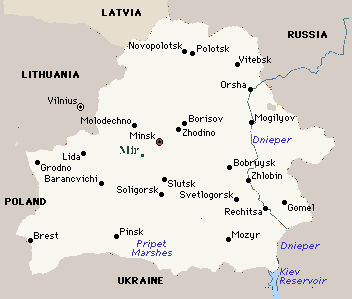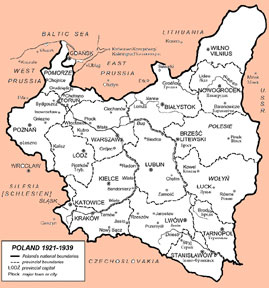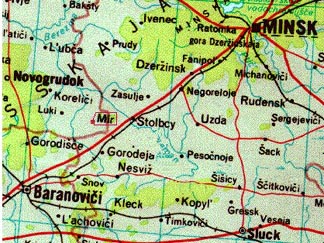A
History of the Jews of Mir, Belarus |
 |
Beginnings - 17th Century
Jews first began
to settle in the town of Mir early in the 17th century, long
after the town was established. The town is mentioned in
records for 1345. (See History of the Jews of Mir translated from the Mir Yizkor Book for detailed history.) By 1569 it was a possession of R. Radzivil-Sirotka
who owned the castle,
a building which has been the object of many attacks over
the centuries. The town and the estates surrounding it were
the possessions of the Radziwill princes.
Initially, the Jews
of Mir were under the jurisdiction of the community of
Nesvizh , about 15 miles away. As the Jewish population of
Mir rapidly grew, they developed their own community organizations. |
Jews were involved in local
trade and in the fairs held in Mir twice a year. Jews from
all parts of Poland and Lithuania came to the fairs at Mir
to trade furs, horses, oxen, spices, grain, textiles, tobacco
and wine. Jews were also the carters whose wagons moved the
traded items.
Encyclopedia Judaica reports that from 1673
the taxes owed by the Jews of Lithuania to state institutions
and debts to other creditors were occasionally collected at
the Mir fairs. In 1685, after complaints by the Jewish representatives,
Catherine Sapieha of the Radziwill family instructed the
administrator of the town to respect the rights of the Jews
and to refrain from dispensing justice or arbitrating in their
internal affairs.
18th - 19th Century
At the beginning of the
1700s, the Jewish population continued to increase,
as evidenced by the records of Jewish contributions to
the poll tax. There are also records which indicate that merchants
of Mir were in communication with Leipzig, Koenigsberg,
Memel and Libau.There were over eight hundred Jews in Mir by
1806. Some were tailors, goldsmiths, cord-makers and merchants.
In the 65 nearby villages there were fewer than 500 Jews
in 1818. By the end of the 19th century, there were more than
3,000 Jews in Mir (62% of the town population). Most were
craftsmen such as scribes, carters, butchers, and tailors. The wealthier Jews were merchants dealing with wood,
grain, horses and textiles.
By the 1850s,
many people in Mir were poor. According to an official newspaper
in the Minsk Guberniya that reported on poverty in each town
of every district , Mir had a population of 1464 in 1858.
Of those 1200 were considered poor.(1) But the Jews built
a wooden synagogue about that time, which was used for about 50 years before
it was destroyed by fire in 1901.
Famous rabbis had officiated
in Mir, such as R. Meir b. Isaac Eisenstadt, R. Zevi Hirsch
ha-Kohen Rappoport, R. Solomon Zalman b. Judah Mirkish, R.
Zevi Hersh Eisenstadt. During the rabbinate of R. Joseph
David Ajzenstat (1776- 1826) the famous Mir Yeshiva was founded
(1815). The Yeshiva becamea central part of the spiritual life
of the Jewish townspeople. Later, in the beginning of the 19th
century Habad Hasidism acquired considerable influence in the
community.
Jews were leaving Mir in significant numbers
by the end of the 19th century. They emigrated to escape pogroms
and poverty. Some went to large cities in the eastern United
States. (There was at least one Mir Congregation on
the lower east side of New York City by 1890.) Others
went to small towns in the Midwest where the climate and
geography were much like their homeland and economic opportunities
were not so limited.
Mir has been threatened many times.
The Napoleonic invasion was disastrous.
20th Century
Mir Jews responded to threats of pogroms in
1904-5 by organizing a self-defense organization. There were
other organizations formed, including the Bund and Po'alie
Zion.
In 1905 a published
list of town populations reports 1463 people living
in Mir. Of those, 1200 were considered poor. (From newspaper
list translated by Vitaly Charny). |
WWI resulted in destruction and more economic
hardships. During WWI the Mir Yeshiva headed by R. Eliezer
Jedah Finkel, moved to Poltava, in the Ukraine and did not
return until 1921.
The success of the Russian Revolution, during
the First World War resulting in great changes thoughout
the Pale of Settlement. By war's end, Poland became an independent
nation, with wide borders. Mir, close to the eastern edge
of Poland, became a Polish town in the district of Nowogrodek. The nearby city of Minsk was now in the new
USSR. (click on map)
By 1921, in spite
of the significant emigration, there were 2,074 Jews (55%
of the population) living in the town. By 1929 there were 365
listed businesses in
the town which had reported a total population of 3,741 as
of January 1928. The economic situation continued to deteriorate
during the 1920s and Jews had difficulty supporting schools
and libraries. Mir had a Yiddish elementary school and kindergarten
(founded in 1917) as well as Tarbut, Yavneh and Beth Jacob
schools. The Jewish library had been founded in 1908. |

Click image for larger map
|
Between 1939 and 1941, under Soviet rule,
many business and even large buildings were taken over by the
government. The Mir Yeshiva left again. Rabbi Finkel,
many other rabbis and yeshiva students went to Lithuania because
that country was still independent. About 300 people associated
with the Mir Yeshiva went to Kaiden early in 1940*.
The story of the escape of Mir Yeshiva to Shanghai during WWII,
thanks to visas issued by Chiune Sugihara, the Japanese consul-general
to Lithuania, has been the subject of several books. After
the war, the rabbis and students founded the Mir Yeshiva in
Brooklyn, New York. R. Finkel survived to establish the Mir
Yeshiva in Jerusalem.
The Germans captured Mir on June 27, 1941. First
they executed Jews on charges of Soviet collaboration. On Nov. 9, 1941, 1,300 Jews were murdered on the outskirts of the town By May of 1942 the remaining Jews were confined
to an ancient fortress in the city. Some of the young people
escaped and joined resistance movements. All those who remained
in the town were murdered. The 200 or more in the resistance
movement lived in the forests. Those who could joined Soviet
partisan units, mainly the Brothers Bielski brigade and took part in sabotage activities. Jewish
partisans from Mir continued fighting the Nazis until the war
ended. (See Mir in US Holocaust Memorial Museum Encyclopedia for details.)
Mir, in the mid 1990s was a small town with a population
of 2,600 people. None of the Jews who were born in Mir live
there today. |
Notes
Much of the information
above comes from Encyclopedia Judaica 1978 edition.
(1) data
provided by Vitaly Charny, who translated it from 1905 newspapers
and posted it to the Belarus SIG discussion group
Vitaly
Charny has also translated the family names of people living
in Mir in 1816, from the Mir 1816 Revision List.
The list is posted on the Belarus
SIG web site. According to "Where Once We
Walked" Mir is a town in Minsk Guberniya, Belarus (Byelorussia,
White Russia) located about 50 miles (88 km) southwest of Minsk,
the capital. Its exact location is 53.27 degrees N - 26.25
degrees S. 1921 Jewish population - 2,074.
The Soviet Encyclopedia
lists Mir as an urban-type settlement in the Korelichi Raion,
Grodno, 17 km from the Gorodeia railroad station on the Mensk-Baranovichi
line. A Belarus web site says:
Mir is a town in the Karelicy district, Hrodna
region, 26 km south-east of Karelicy, 17 km north-west of Garadzeia,
a railway station at the railway Brest-Mensk. Population
2,600 (1995)
Mir is
currently in the Novogrudok District, in the Minsk Oblast of Belarus (2014) |
| It is difficult to look for books on Mir, the town, because the word "mir" has
many meanings. Mir is a name given the rural peasant commune
as well as the posad (urban) commune in Russia from the 13th
to the early 20th century. Since the 13th century, the mir
existed in villages and settlements on state, palace, boyar
and monasterial lands. Mir is also the name given a Soviet
space ship. Mir means peace in Russian. |
|
Links to other web pages
Nearby town with a web
site: Nesvizh. Click
to visit this informative site.
*About 300 rabbis, students and families
associated with the Mir Yeshiva escaped to Keidan, Lithuania
early in 1940. There are contemporary reports of their
move and resettlement in Keidan written (in Yiddish) for
the monthly bulletin of the Keidaner Association of New
York by B. Cassel, grandfather of Andrew Cassel, who set
up the Keidan Shtetl site. The site contains numerous articles,
stories and poems relating to Keidan's history.
Details of Belarus History and politics can
be found on the Virtual
Guide to Belarus
More Maps
of Belarus |
 History of Mir at Beit Hatfutsot The Museum of the Jewish People History of Mir at Beit Hatfutsot The Museum of the Jewish People
 Jewishgen Kehilalinks site for Mir Jewishgen Kehilalinks site for Mir
Jewishgen has
a web site
for the Belarus SIG which features an on-line newsletter.
There is an active Belarus SIG discussion group, search
engines with access to hundreds of pages of indexes to
old records and more.

Detailed maps of Mir |
|
Updated
June 2018
|